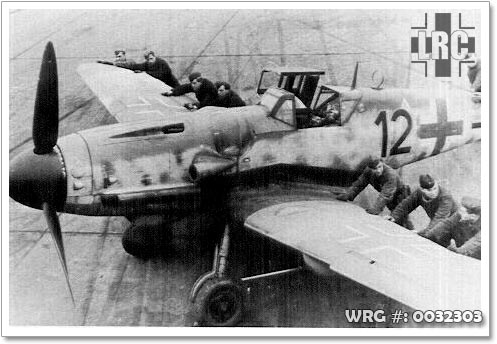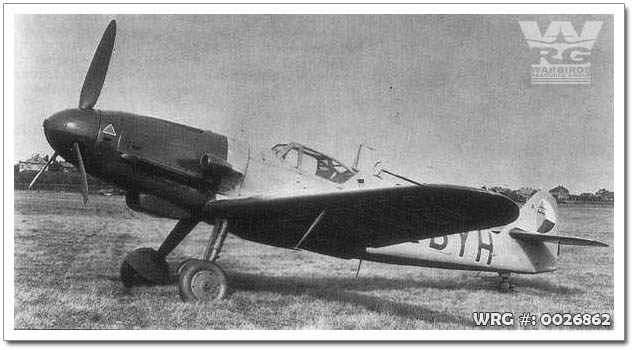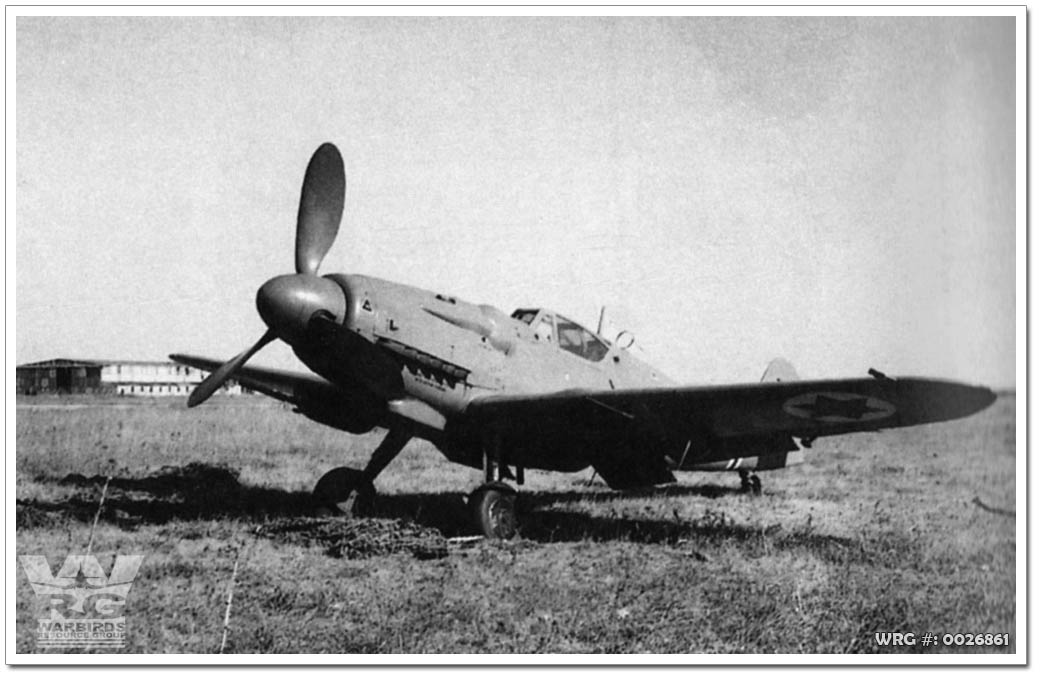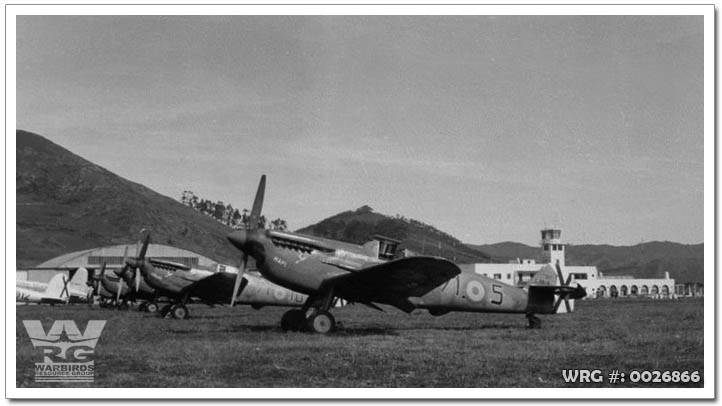LUFTWAFFE RESOURCE CENTER > FIGHTERS/DESTROYERS > BF 109 > PREVIOUS PAGE
Variants
The Bf 109A was the first version of the Bf 109. Armament was initially planned to be just two cowl-mounted 7.92 mm MG 17 machine guns. However, possibly due to the introduction of the Hurricane and Spitfire, each with eight 7.7 mm machine guns, experiments were carried out with a third machine gun firing through the propeller shaft. V4 and some A-0 were powered by a 640 PS (631 hp, 471 kW) Junkers Jumo 210B engine driving a two-blade fixed-pitch propeller, but production was changed to the 670 PS (661 hp, 493 kW) Jumo 210D as soon as it became available. The A-0 was not of a uniform type; there were several changes in their appearance. Visible changes included engine, cockpit and machine gun ventilation holes/slats, and the location of the oil cooler was changed several times to prevent overheating. Many of these Bf 109 A-0 served with the Legion Condor and were often misidentified as B-series aircraft, and probably served in Spain with the tactical markings 6-1 to 6–16. One A-0, marked as 6–15, ran out of fuel and was forced to land behind enemy lines. It was captured by Republican troops on 11 November 1937 and later transferred to the Soviet Union for a closer inspection. 6–15 incorporated several improvements from the Bf 109B production program and had been prepared to use a variable-pitch propeller although it had not been installed. According to RLM documentation 22 aircraft were ordered and delivered with V4 as the A-series prototype. Bf 109B
The first Bf 109 in serial production, the Bf 109 B-1, was fitted with the 670 PS (661 hp, 493 kW) Jumo 210D engine driving a two-bladed fixed-pitch propeller. During the production run a variable-pitch propeller was introduced and often retrofitted to older aircraft; these were then unofficially known as B-2s. The Bf 109B saw combat with the Legion Condor during the Spanish Civil War, although it was apparent that the armament was still inadequate. Several aircraft were produced with an engine-mounted machine gun but it was very unreliable, most likely because of engine vibrations and overheating. Thus the Bf 109 V8 was constructed to test the fitting of two more machine guns in the wings; however, results showed that the wing needed strengthening. In the following V9 prototype, both wing guns were replaced by 20 mm MG FF cannons.

Messerschmitt Bf 109B in flight.
[Source: Unknown]
Production of the short-lived Bf 109C began in the spring of 1938. The 109C was powered by a 700 PS (690 hp, 515 kW) Jumo 210G engine with direct fuel injection. Another important change was a strengthened wing, now carrying two more machine guns, giving four 7.92 mm (.312 in) MG 17s in total. The C-0s were pre-production aircraft, the C-1 was the production version, and the C-2 was an experimental version with an engine-mounted machine gun. The C-3 was planned with 20 mm MG FF cannons replacing the two MG 17s in the wings, but it is not known how many C-3s (if any) were built or converted. The C-4 was planned to have an engine-mounted Motorkanone MG FF, but this variant was not produced. A total of 58 Bf 109Cs of all versions were built by Messerschmitt. Bf 109D
Developed from the V10 and V13 prototypes, the Bf 109D was the standard version of the Bf 109 in service with the Luftwaffe just before the start of World War II. Despite this, the type saw only limited service during the war, as all of the 235 Bf 109Ds still in Luftwaffe service at the beginning of the Poland Campaign were rapidly taken out of service and replaced by the Bf 109E, except in some night fighter units where some examples were used into early 1940. Variants included the D-0 and D-1 models, both having a Junkers Jumo 210D engine and armed with two wing-mounted and two nose-mounted 7.92 mm (.312 in) MG 17s.> The D-2 was an experimental version with an engine-mounted machine gun, but as previously tried, this installation failed. The D-3 was similar to the C-3 but with two 20 mm MG FFs in the wings. A total of 647 Bf 109Ds of all versions were built by Focke-Wulf, Erla, Fieseler, Arado and AGO. Messerschmitt is listed as having produced only four Bf 109Ds, probably the D-0 preproduction series with the serial production transferred to the licensed manufacturers. Several Bf 109Ds were sold to Hungary. Switzerland bought 10 109D-1s (Serial Numbers from 2301 until 2310) which had been built by the Arado-Flugzeugwerke GmbH factory located in Warnemünde. Bf 109E - Emil
In late 1938, the Bf 109E entered production. To improve on the performance afforded by the 441–515 kW (600–700 PS) Jumo 210, the larger, longer Daimler-Benz DB 601A engine was used, yielding an extra 223 kW (300 PS) at the cost of an additional 181 kg (400 lb). A much bigger cooling area was needed to disperse the extra heat generated by the DB 601 and this led to the first major redesign of the basic airframe. more... Bf 109F - Friedrich
Development of the new Bf 109 F airframe had begun in 1939. After February 1940, an improved engine, the Daimler-Benz DB 601E, was developed for use with the Bf 109. The engineers at the Messerschmitt facilities took two Bf 109 E-1 airframes and installed this new powerplant. The first two prototypes, V21 (Werknummer (Works number) or W.Nr 5602) and V22 (W.Nr 1800) kept the trapeziform wing shape from the E-1, but the span was reduced by 61 cm (2 ft) by "clipping" the tips. Otherwise the wings incorporated the cooling system modifications described below. V22 also became the testbed for the pre-production DB 601E. The smaller wings had a detrimental effect on the handling so V23, Stammkennzeichen (factory Code) CE+BP, W.Nr 5603, was fitted with new, semi-elliptical wingtips, becoming the standard wing planform for all future Bf 109 combat versions. The fourth prototype, V24 VK+AB, W.Nr 5604, flew with the clipped wings but featured a modified, "elbow"-shaped supercharger air-intake, which was eventually adopted for production, and a deeper oil cooler bath beneath the cowling. On all of these prototypes, the fuselage was cleaned up and the engine cowling modified to improve aerodynamics. more... Bf 109G - Gustav
The Bf 109 G-series was developed from the largely identical F-series airframe, although there were detail differences. Modifications included a reinforced wing structure, an internal bullet-proof windscreen, the use of heavier, welded framing for the cockpit transparencies, and additional light-alloy armour for the fuel tank. It was originally intended that the wheel wells would incorporate small doors to cover the outer portion of the wheels when retracted. To incorporate these the outer wheel bays were squared off. Two small inlet scoops for additional cooling of the spark plugs were added on both sides of the forward engine cowlings. A less obvious difference was the omission of the boundary layer bypass outlets, which had been a feature of the F-series, on the upper radiator flaps. more...

Messerschmitt Bf 109G.
[Source: Unknown]
The Bf 109H was intended to be a high-altitude fighter, developed from the F-series. The wingspan was increased through the addition of new, constant-chord inner wing panels to 11.92 m (39.11 ft), and the widened stabilizer again received a supporting strut leading from the fuselage, like the B through E models. Maximum speed was 750 km/h (470 mph) at 10,100 m (33,140 ft). A small number of Bf 109 H-1s were built, flying several sorties over Britain and France. Bf 109H-2 and H-5 developments were also planned, but the entire H-series was scrapped because of wing flutter problems. • H-0 (Pre-production aircraft, rebuilt from F-4/Z, powered by a DB 601E engine with GM-1 boost)
• H-1 (Production version, based on G-5, powered by a DB 605A engine with GM-1 boost) A record exists of one particular Bf 109H-1, Werknummer 110073, was recorded as having been converted to a photo-recon aircraft by a Luftwaffe long-range reconnaissance group, Fernaufklärungsgruppe 123, in May 1944, and flown on dates immediately following the Invasion of Normandy with one mission meant to scan the entire French coastline from Cherbourg to Ouistreham, from an altitude of some 15 km (49,200 ft), which proved to be just beyond the achievable ceiling of the selected aircraft. Bf 109K - Kurfürst
The Bf 109K was the last of the series to see operational duty and the last in the Bf 109 evolutionary line. The K series was a response to the bewildering array of series, models, modification kits and factory conversions for the Bf 109, which made production and maintenance complicated and costly – something Germany could ill-afford late in the war. The RLM ordered Messerschmitt to rationalise production of the Bf 109, consolidating parts, types, and so on, to produce a uniform, standard model with better interchangeability of parts and equipment. At the same time, the existing flaws of the design were to be remedied. Work on the new version began in the spring of 1943, and the prototype was ready by the autumn of that year. Series production started in August 1944 with the K-4 model, due to changes in the design and delays with the new DB 605D powerplant. The K-4 was the only version to be mass-produced. more... Bf 109T - Träger
Prior to the war, the Kriegsmarine had become fascinated with the idea of the aircraft carrier. Borrowing ideas from the British and Japanese (mainly Akagi), they started the construction of Graf Zeppelin as part of the rebuilding of the navy. The air group for the carrier was settled on Messerschmitt Bf 109T fighters and Ju 87C dive bombers. The suffix 'T' denotes Träger (carrier) in German use. more... Avia S-99
After the war ended, Avia continued building Messerschmitt Bf 109G-6s. Renaming it the Avia S-99 name, at two aircraft factories in Czechoslovakia from 1946-1948. Eventually a lack of powerplants forced as redesign resulting in the S-199.

Czechoslovak Air Force S-99.
[Source: Unknown]
The Avia S-199 continued to use the Bf 109G airframe but like the S-99, but with no more Daimler-Benz DB 605s available, an alternative engine had to be used. the Junkers Jumo 211 F (as used in the Heinkel He111 bomber, along with the associated propellor) was chosen as the replacement powerplant. The resulting combination of parts was an aircraft with extremely poor handling qualities. The substitute engine with the propeller lacked the responsiveness of the Daimler-Benz unit and the torque created by the massive paddle-bladed propeller made control very difficult. The aircraft was generally unpopular with its pilots. Czechoslovak pilots nicknamed it Mezek ("Mule"), while in Israel it was officially known as the Sakeen ("knife" in Hebrew). In practice, the aircraft was more often called Messerschmitt or Messer (which also means "knife", in German and Yiddish).

Israeli Air Force Avia S-199 of the 101st squadron in June 1948.
[Source: Unknown]
Built post-War in Spain Hispano Aviación Ha 1112
Built post-War in Spain

Spanish Air Force HA-1112s.
[Source: Unknown]
LUFTWAFFE RESOURCE CENTER > FIGHTERS/DESTROYERS > BF 109 > PREVIOUS PAGE
